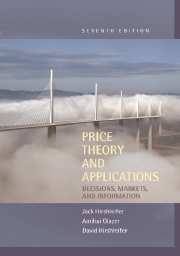Book contents
- Frontmatter
- Contents
- Preface
- PART ONE INTRODUCTION
- PART TWO PREFERENCE, CONSUMPTION, AND DEMAND
- PART THREE THE FIRM AND THE INDUSTRY
- PART FOUR FACTOR MARKETS AND INCOME DISTRIBUTION
- PART FIVE EXCHANGE
- PART SIX ECONOMICS AND TIME
- 15 The Economics of Time
- PART SEVEN POLITICAL ECONOMY
- Answers to Selected Questions
- Name Index
- Subject Index
15 - The Economics of Time
from PART SIX - ECONOMICS AND TIME
Published online by Cambridge University Press: 05 June 2012
- Frontmatter
- Contents
- Preface
- PART ONE INTRODUCTION
- PART TWO PREFERENCE, CONSUMPTION, AND DEMAND
- PART THREE THE FIRM AND THE INDUSTRY
- PART FOUR FACTOR MARKETS AND INCOME DISTRIBUTION
- PART FIVE EXCHANGE
- PART SIX ECONOMICS AND TIME
- 15 The Economics of Time
- PART SEVEN POLITICAL ECONOMY
- Answers to Selected Questions
- Name Index
- Subject Index
Summary
The text so far has covered two types of decisions: (1) how to spend income (what consumption goods to buy?) and (2) how to earn income (how hard to work, what amounts of resource services to offer on the market?). This chapter examines another economic choice: (3) how to provide for the present versus the future.
To balance between present and future consumption, people save and invest. A person who saves is refraining from current consumption. A person who invests is creating “capital” – either physical capital such as factories and machines or human capital (education and training).
An isolated Robinson Crusoe has to simultaneously save and invest. He saves by not eating up all of his current corn crop; he invests by planting the saved corn as seed. In a multiperson economy, however, those who save and those who invest may be different people. Savers might put money in the bank or buy corporate securities. The financial system transfers this purchasing power to finance other people's investments – building a house, enlarging a factory, or acquiring a college education. Although any single person's saving might exceed the amount he or she invests, the economywide totals of saving and investment must be equal.
- Type
- Chapter
- Information
- Price Theory and ApplicationsDecisions, Markets, and Information, pp. 455 - 494Publisher: Cambridge University PressPrint publication year: 2005



